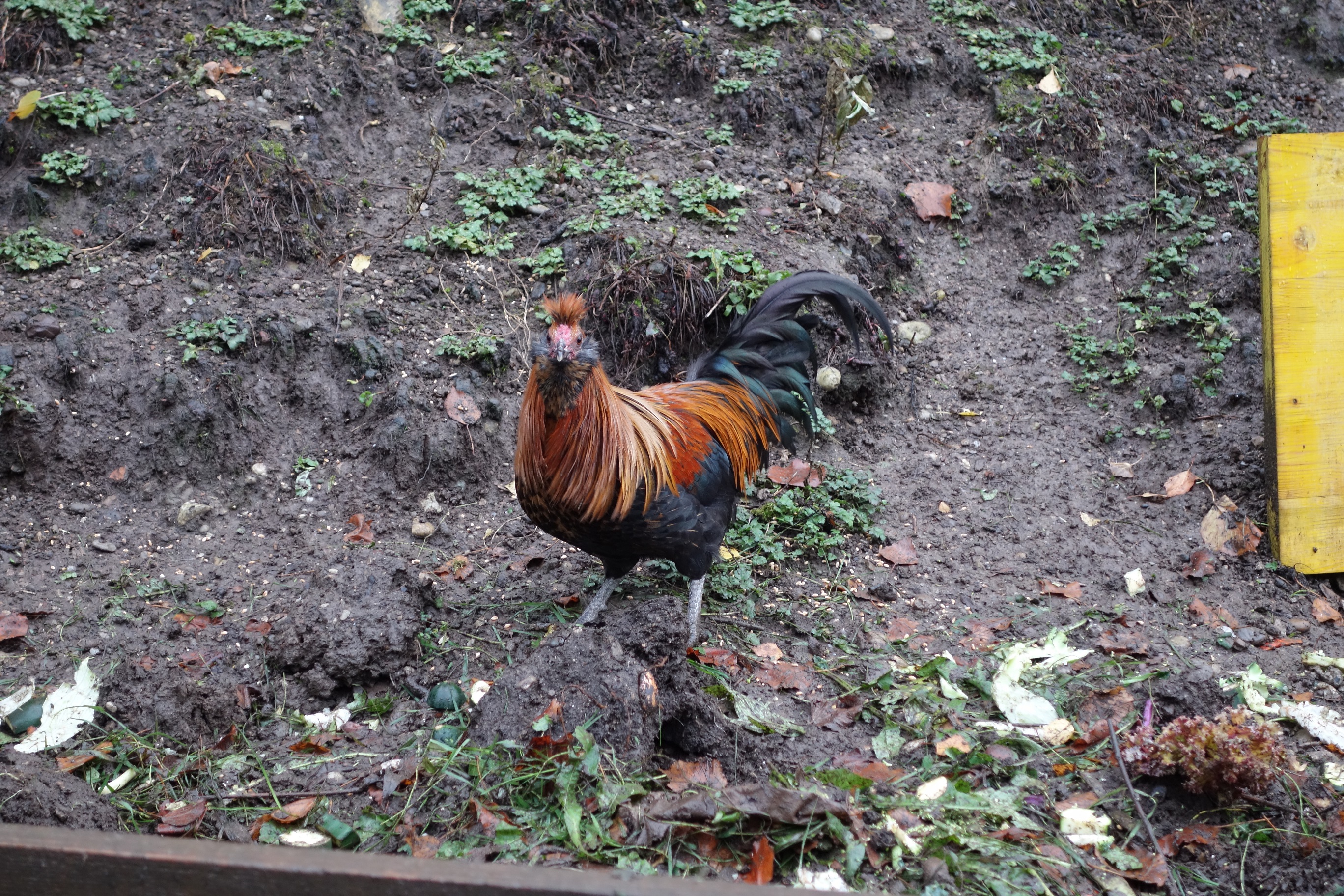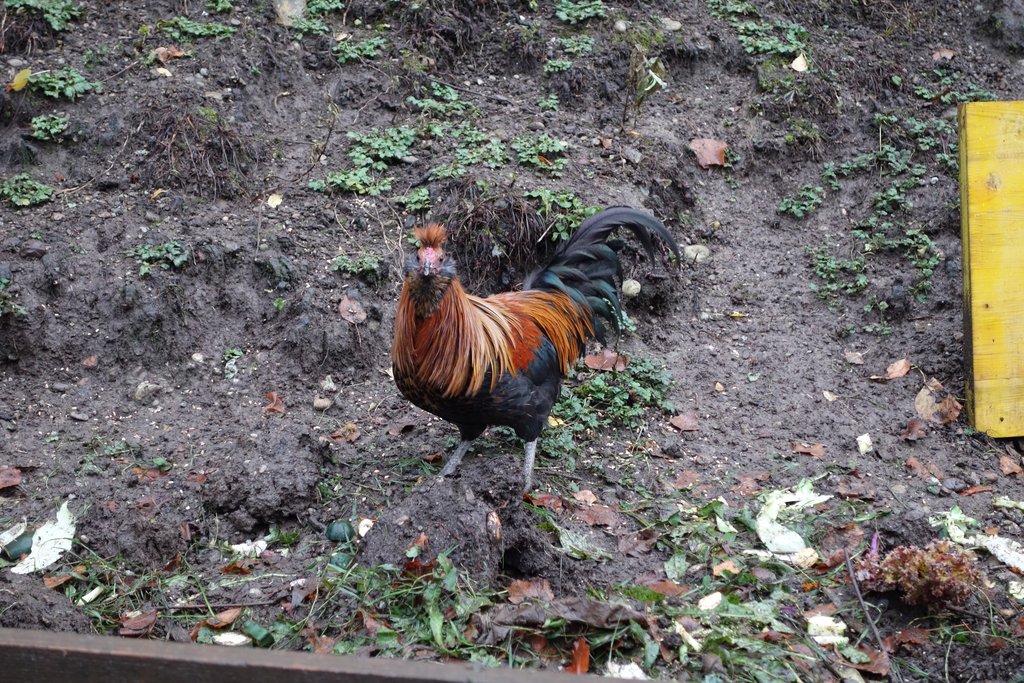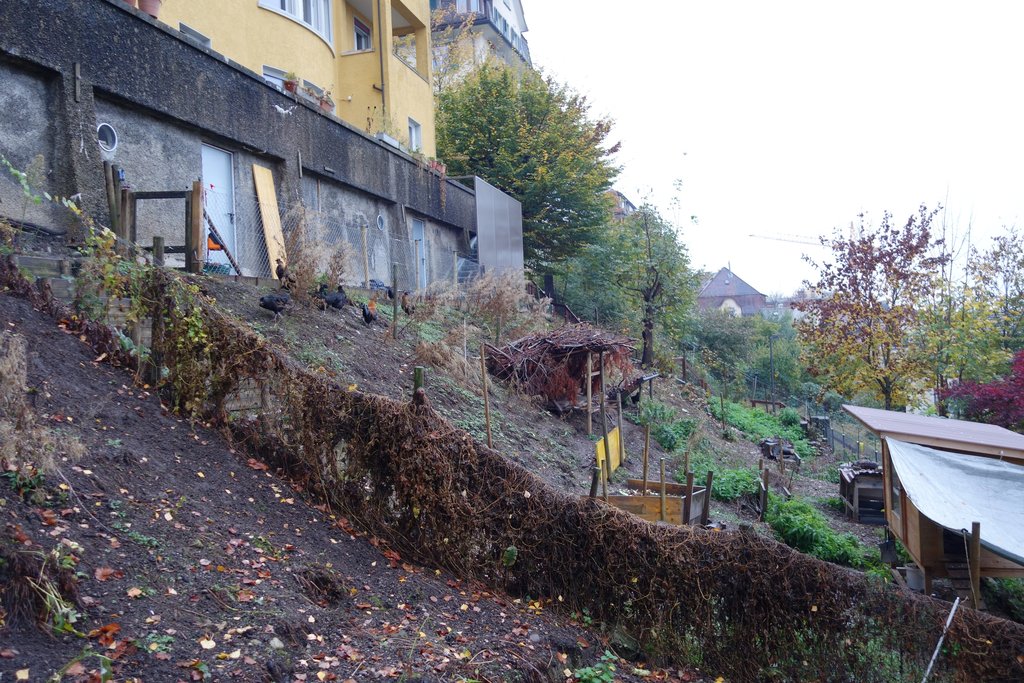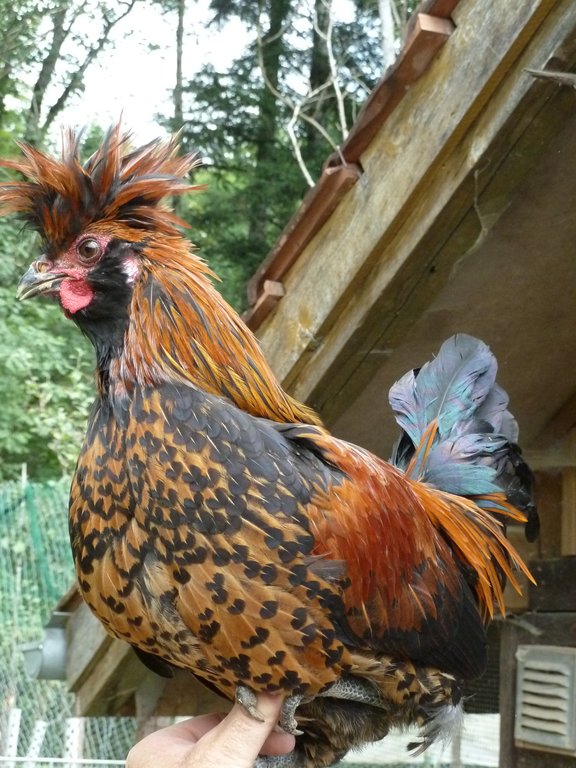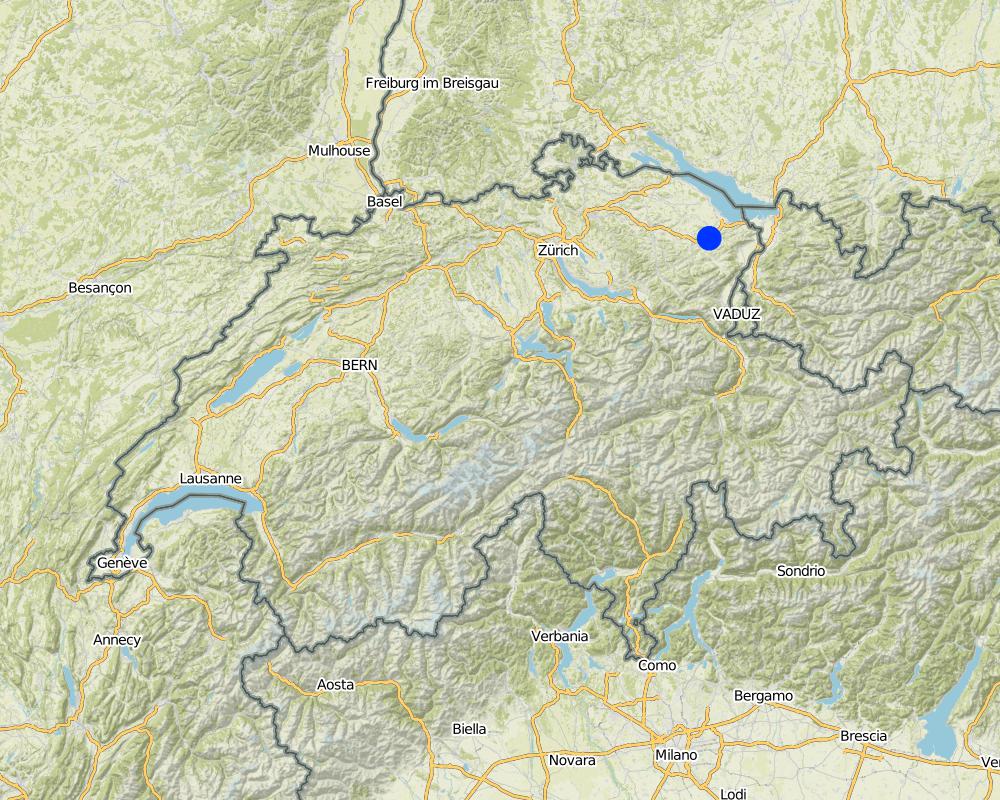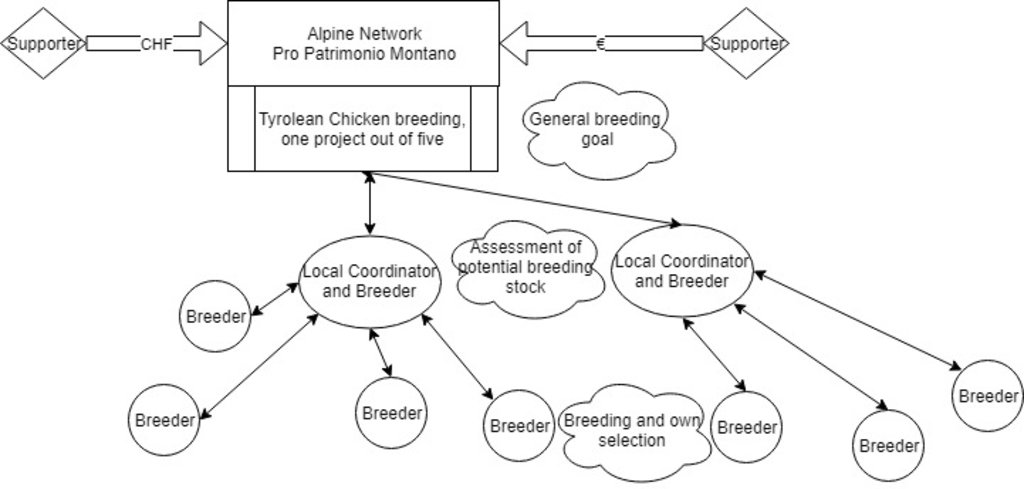Organisation of the breeding for the new Tyrolean Chicken [Switzerland]
- Creation:
- Update:
- Compiler: Stefan Graf
- Editor: –
- Reviewer: Alexandra Gavilano
Zuchtgruppenorganisation für das Neu-Tirolerhuhn
approaches_4165 - Switzerland
View sections
Expand all Collapse all1. General information
1.2 Contact details of resource persons and institutions involved in the assessment and documentation of the Approach
Key resource person(s)
SLM specialist:
Grünenfelder Hans-Peter
www.patrimont.org
Pro Patrimonio Montano
www.patrimont.org
Switzerland
land user:
Waibel Benjamin
Switzerland
Name of the institution(s) which facilitated the documentation/ evaluation of the Approach (if relevant)
Bern University of Applied Sciences, School of Agricultural, Forest and Food Sciences (HAFL) - Switzerland1.3 Conditions regarding the use of data documented through WOCAT
When were the data compiled (in the field)?
29/10/2018
The compiler and key resource person(s) accept the conditions regarding the use of data documented through WOCAT:
Yes
2. Description of the SLM Approach
2.1 Short description of the Approach
A new chicken breed is developed based on three remnants populations having similar looks, with the purpose of recreating a healthy chicken adapted to mounaneous areas.
2.2 Detailed description of the Approach
Detailed description of the Approach:
Chicken with a crest have been known in the alpine areas of Switzerland, Austria and Italy for many centuries, as bone excavations, historic paintings and old pictures show. Crested chicken can still be found in Switzerland, now called “Appenzeller Spitzhauben, and in north-eastern Italy, as Polverara. Members of the association Pro Patrimonio Montano supposed that these chickens are the southeastern and western remnants of the same population of chicken and wondered what would happen if they crossed the two breeds. In 2010 crosses were done in both ways. As the crossed individuals all turned out black, and quite uniform, the initiators decided to start a serious breeding project with the aim of developing a breed adapted to the alpine conditions while relying only on the genetics of the two former chicken breeds. Later a small population of crested chicken, supposed to be other remnants of the Tyrolean chicken, was found on a remote farm in a remote valley, the Sarntal, and integrated into the breeding project of the “New Tyrolean Chicken”. The roosters of descendants of the Sarntal chicken are quite aggressive, reason why it is not used extensively in the new Tyrolean chicken breed.
The breeding is decentralized, with many small-scale farmers, hobby chicken keepers, and other interested persons keeping breeding groups. The breeders are organized in regional groups, with one regional coordinator overseeing 3 to 7 chicken breeders. The regional coordinator is assessing each newly hatched chicken and rooster to select for the ones being kept for further breeding. Selection takes place for morphological traits to match the ancient type of Tyrolean chicken. The selection for this ancient phenotype is due to the fact that the appenzeller Spitzhauben” has been crossed with other chicken because of concern with inbreeding, as the population was based only on a few individuals.
The regional coordinator is compensated for each chicken he or she assesses with 3 CHF/€, and additionally 2 CHF/€ per ring put on a chicken suitable for breeding. The assessment takes place at around 13 weeks. The assessment is then sent on an excel file to the coordinator at Pro Patrimonio Montano, where all files are added together. Each chicken has its ancestors recorded, with the maternal line being merged as sisters bred together.
Pro Patrimonio Montano is organized as an association, overseeing currently five breed and species of animals. The voting inside the organization for changing rules is done by representants of the breeders. Each region with up to 50 breeders has one voice at votes, can therefore send one representative. Regions with more than 50 breeders have two votes, thus two representatives.
2.3 Photos of the Approach
2.5 Country/ region/ locations where the Approach has been applied
Country:
Switzerland
Region/ State/ Province:
As well as Italy and Austria
Map
×2.6 Dates of initiation and termination of the Approach
Indicate year of initiation:
2010
2.7 Type of Approach
- recent local initiative/ innovative
2.8 Main aims/ objectives of the Approach
The objective is to breed a healthy chicken for the alpine region, while keeping the old remaining genetics of crested alpine chicken.
2.9 Conditions enabling or hindering implementation of the Technology/ Technologies applied under the Approach
social/ cultural/ religious norms and values
- enabling
The keeping of ancient breeds starts to be culturally promoted
collaboration/ coordination of actors
- enabling
The fact that different regions have coordinators helps to implement sustainable ways to keep chicken.
policies
- hindering
As it is a project working over three countries, the legal framework is different in each country. The exchange of bloodlines is also hindered due to this.
knowledge about SLM, access to technical support
- enabling
The more is known about chicken keeping, the better they can be kept.
markets (to purchase inputs, sell products) and prices
- hindering
The chicken Tyrolean chicken cannot compete with the hybrids, even if it lays well compared to other ancient breeds. It is more useful in a smaller setting than on an industrial scale.
3. Participation and roles of stakeholders involved
3.1 Stakeholders involved in the Approach and their roles
- local land users/ local communities
Hobby chicken keepers as well as small scale farmers
They breed the chicken, and some breeders are regional coordinators. The regional coordinators assess the new animals to see if they can be kept as breeders or removed from the gene pool.
- NGO
The breeding takes place under the umbrella of the NGO Pro Patrimonio Montano, who is currently overseeing five alpine animal breeds.
Provides the legal framework as an association.
3.2 Involvement of local land users/ local communities in the different phases of the Approach
| Involvement of local land users/ local communities | Specify who was involved and describe activities | |
|---|---|---|
| initiation/ motivation | self-mobilization | Two breeders, one of polverara chicken, the other of Appenzeller spitzhauben, decided to see what would happen if the two breeds were crossed. Out of this, the project started. |
| planning | interactive | The initiators, being only two, found others with which they could breed the new Tyrolean chicken. |
| implementation | interactive | As two breeders on a small scale are not enough, others joined. |
| monitoring/ evaluation | interactive | The egg laying is monitored only by a few chicken keepers. An evaluation of the breeding stock takes place for every animal about to enter the gene pool. |
3.3 Flow chart (if available)
Description:
Pro Patrimonio Montano (Patrimont) is the association under which the breeding of the New Tyrolean Chicken takes place. Patrimont is financed by supporters, and is a tax-deductible association in Switzerland.
Patrimont decided on a general phenotype (breeding goal) for the new tyrolean chicken. It does not recognize animals which are outcrossed for a better look or color, as it wants to keep the genetics of the alpine crested chicken.
The breeders, who can be farmers, hobby keepers, or other (zoo...) breed the chicken which are then assessed by a regional coordinator. If they meet the requirements of Patrimont, the breeder can use them for further breeding. Usually, the hens are kept, and the roosters are exchanged or sold. The regional coordinator keep a record on the ancestry of each chick hatched, and coordinate exchange of roosters, even among regional groups.
Author:
Stefan Graf
3.4 Decision-making on the selection of SLM Technology/ Technologies
Specify who decided on the selection of the Technology/ Technologies to be implemented:
- mainly land users, supported by SLM specialists
Explain:
All the chicken keepers chose to breed or not. Regional coordinators help with the selection of the breeding stock.
Specify on what basis decisions were made:
- evaluation of well-documented SLM knowledge (evidence-based decision-making)
- personal experience and opinions (undocumented)
4. Technical support, capacity building, and knowledge management
4.1 Capacity building/ training
Was training provided to land users/ other stakeholders?
Yes
Specify who was trained:
- field staff/ advisers
Form of training:
- on-the-job
- courses
Subjects covered:
Selection of the breeding stock. The training is only for the regional coordinators.
4.2 Advisory service
Do land users have access to an advisory service?
Yes
Specify whether advisory service is provided:
- on land users' fields
Describe/ comments:
The advisory service is given by the regional coordinators.
4.3 Institution strengthening (organizational development)
Have institutions been established or strengthened through the Approach?
- yes, moderately
Specify the level(s) at which institutions have been strengthened or established:
- regional
Describe institution, roles and responsibilities, members, etc.
The regional coordinators were put in place to coordinate the breeding and to advise the chicken keepers.
Specify type of support:
- capacity building/ training
4.4 Monitoring and evaluation
Is monitoring and evaluation part of the Approach?
Yes
Comments:
A monitoring and evaluation of the breeding stock only takes place before the onset of the laying. The egg production is only evaluated by a few chicken keepers.
If yes, is this documentation intended to be used for monitoring and evaluation?
No
4.5 Research
Was research part of the Approach?
Yes
Give further details and indicate who did the research:
The project started as an experiment to research what would happen if the Polverara and the Appenzeller Spitzhauben chicken were crossed.
5. Financing and external material support
5.1 Annual budget for the SLM component of the Approach
If precise annual budget is not known, indicate range:
- < 2,000
Comments (e.g. main sources of funding/ major donors):
Mainly donations via the association Pro Patrimonio Montano.
In the early years of the project, the budget was higher due to the necessary animal transports.
5.2 Financial/ material support provided to land users
Did land users receive financial/ material support for implementing the Technology/ Technologies?
No
5.3 Subsidies for specific inputs (including labour)
- other
| Other (specify) | To which extent | Specify subsidies |
|---|---|---|
| Breeding stock | fully financed | In the beginning of the project, chicken were given free of charge to the keepers, with the condition that they had to give back breeding stock. |
5.4 Credit
Was credit provided under the Approach for SLM activities?
No
5.5 Other incentives or instruments
Were other incentives or instruments used to promote implementation of SLM Technologies?
No
6. Impact analysis and concluding statements
6.1 Impacts of the Approach
Did the Approach mobilize/ improve access to financial resources for SLM implementation?
- No
- Yes, little
- Yes, moderately
- Yes, greatly
As there is an association behind the breeding of the tyrolean chicken, the regional coordinators get a small compensation for the assessment of the breeding stock.
Did the Approach improve knowledge and capacities of other stakeholders?
- No
- Yes, little
- Yes, moderately
- Yes, greatly
The regional coordinators are trained to assess the potential breeding stock.
Did the Approach build/ strengthen institutions, collaboration between stakeholders?
- No
- Yes, little
- Yes, moderately
- Yes, greatly
The regional coordinators help the chicken keepers in their region.
Did the Approach lead to improved food security/ improved nutrition?
- No
- Yes, little
- Yes, moderately
- Yes, greatly
As biodiversity of the food base, the chicken in this case, is important for future food security, the in-situ conservation of other breeds counters the loss due to the concentration of the breeding of livestock.
6.2 Main motivation of land users to implement SLM
- prestige, social pressure/ social cohesion
The Tyrolean chicken looks better than a random hybrid chicken.
- environmental consciousness
The loss of biodiversity and the need to breed locally is a factor for some breeders.
- aesthetic improvement
The Tyrolean chicken looks more interesting than the laying hybrids.
6.3 Sustainability of Approach activities
Can the land users sustain what has been implemented through the Approach (without external support)?
- yes
6.4 Strengths/ advantages of the Approach
| Strengths/ advantages/ opportunities in the land user’s view |
|---|
| The organisation is adapted to the need of the breeders. |
| Strengths/ advantages/ opportunities in the compiler’s or other key resource person’s view |
|---|
| Knowledge is spread about the conservation of genetic resources and backyard poultry keeping. |
6.5 Weaknesses/ disadvantages of the Approach and ways of overcoming them
| Weaknesses/ disadvantages/ risks in the compiler’s or other key resource person’s view | How can they be overcome? |
|---|---|
| The new Tyrolean Chicken is not assessed for the egg laying, and can therefore not be selected for it. | Subsidise automatic electronic egg traps, for example based on RFID chips on chicken legs. |
| The new Tyrolean chicken may replace other rare breeds. | The biggest threat to biodiversity is industrial agriculture, therefore the promotion of other initiatives like the new Tyrolean chicken can counter this loss of biodiversity. The new Tyrolean chicken complements the other available breeds. |
7. References and links
7.1 Methods/ sources of information
- field visits, field surveys
Three chicken keepers were asked
- interviews with land users
- interviews with SLM specialists/ experts
One of the initiants of the project.
7.2 References to available publications
Title, author, year, ISBN:
Agricultural Genetic Resources in the Alps, Monitoring Institute for Rare Breeds and Seeds in Europe, 2003, ISBN 3-258-06669-8
Available from where? Costs?
Available from Pro Patrimonio Montano
7.3 Links to relevant information which is available online
Title/ description:
Pro Patrimonio Montano
URL:
patrimont.org
Title/ description:
An RFID-Based Smart Nest Box: An Experimental Study of Laying Performance and Behavior of Individual Hens
URL:
https://www.ncbi.nlm.nih.gov/pubmed/29538334
Title/ description:
Umwelt und Artgerechte Legehennenhaltung. Entwicklung und Erprobung von elektronischen Registrierungssystemen. Ab S. 99
URL:
https://docplayer.org/63001785-High-tech-innovationen-fuer-verfahrensketten-der-agrarproduktion.html
Title/ description:
Trial with automatic egg count
URL:
https://www.cabi.org/Uploads/animal-science/worlds-poultry-science-association/WPSA-italy-2006/10204.pdf
Links and modules
Expand all Collapse allLinks
No links
Modules
No modules


